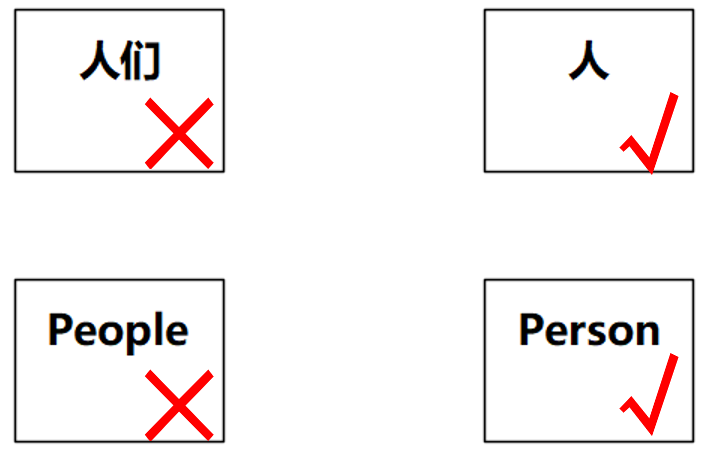1 Spring
1.1 简介
-
Spring 春天–>给软件行业带来了春天
-
2002 首次推出了spring框架的雏形,interface21框架
-
spring框架即以interface21框架为基础,经过重新设计 ,并不断丰富其内涵,与2004年3月24日,发布了11.0正式版
-
Rod Johnson 该框架的创始人,著名作者,音乐学的博士,悉尼大学
-
spring理念,使现有的技术更加容易使用,本身是一个大杂烩
-
SSH:Struct2+Spring+Hibernate
-
SSM:SpringMvc+Spring+Mybatis
<!-- https://mvnrepository.com/artifact/org.springframework/spring-webmvc -->
<dependency><groupId>org.springframework</groupId><artifactId>spring-webmvc</artifactId><version>5.3.18</version>
</dependency>
<!-- https://mvnrepository.com/artifact/org.springframework/spring-webmvc -->
<dependency><groupId>org.springframework</groupId><artifactId>spring-jdbc</artifactId><version>5.3.18</version>
</dependency>1.2 优点
- spring是一个开源免费的框架(容器)
- Spring 是一个轻量级的、非入侵的框架(不会对源码产生任何影响,只会简化代码)
- 控制反转(IOC),面向切面编程(AOP)
- 支持事务的处理,对框架整合的支持
总结一句话,Spring就是一个轻量级的控制反转IOC和面向切面编程AOP的框架
1.3 组成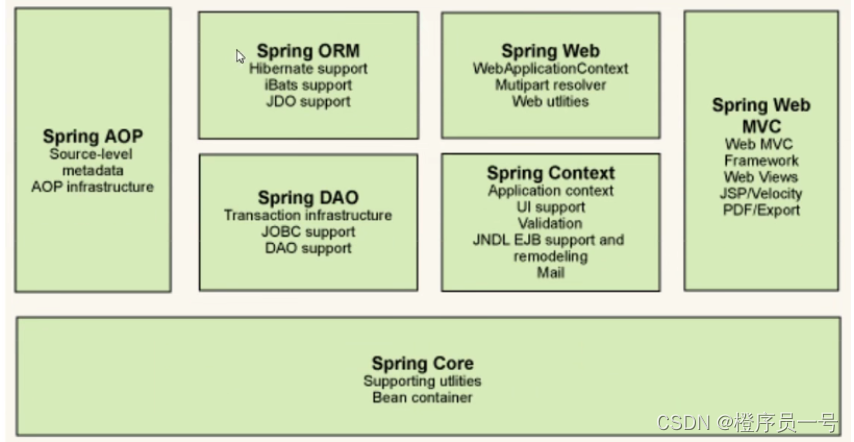
1.4扩展
在Spring的官网有这个介绍:现代化的java开发,说白就是基于spring的开发
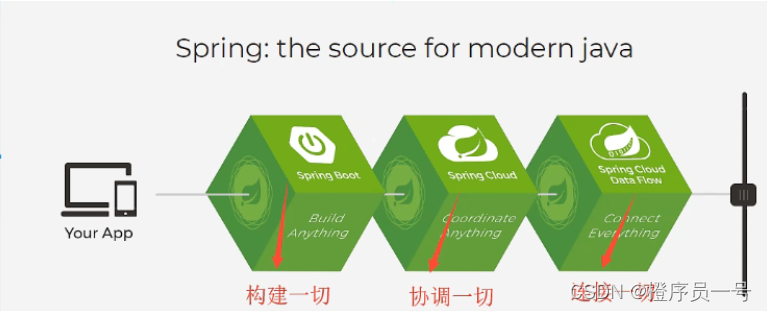
- spring boot
- 一个快速开发的脚手架
- 基于springboot可以快速的开发单个微服务
- 约定大于配置!
- spring cloud
- springCloud是基于springboot实现的
因为现在大多数公司都在使用springBoot进行快速开发,学习springboot的前提,需要完全掌握spring及springMVC
弊端:发展了太久,违背了原来的理念!配置十分繁琐,人称“配置地狱!”
2.IOC理论推导
- UserDao接口
- UserDaoImpl实现类
- UserService业务接口
- UserServiceimpl业务实现类
在我们之前的业务中,用户的需求可能会影响我们原来的代码,我们需要根据用户的需求去修改源代码!如果程序代码量十分大,成本巨大。

我们使用一个set接口实现,已经发生革命性的变化!
private UserDao userDao;
public void setUserDao(UserDao userDao){this.userDao=userDao;
}
- 之前,程序是主动创建对象!控制权在程序猿手上!
- 使用set注入后,程序不在具有主动性,而是变成被动的接受对象
这种思想,从本质上解决了问题,我们程序猿不用再去管理对象的创建了,系统的耦合性大大降低,可以更加专注在业务的实现上。这是IOC的原型。
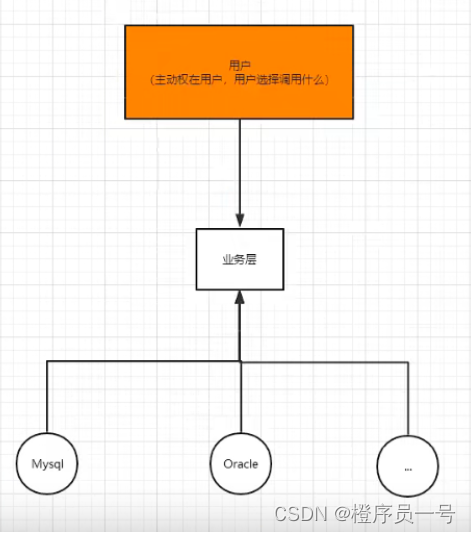
IOC本质
控制反转IoC(Inversion of Control),是一种设计思想,DI(依赖注入)是实现IoC的一种方法,也有人认为DI只是IoC的另一种说法。没有IoC的程序中 , 我们使用面向对象编程 , 对象的创建与对象间的依赖关系完全硬编码在程序中,对象的创建由程序自己控制,控制反转后将对象的创建转移给第三方,个人认为所谓控制反转就是:获得依赖对象的方式反转了。
采用XML方式配置Bean的时候,Bean的定义信息是和实现分离的,而采用注解的方式可以把两者合为一体,Bean的定义信息直接以注解的形式定义在实现类中,从而达到了零配置的目的。
控制反转是一种通过描述(XML或注解)并通过第三方去生产或获取特定对象的方式。在Spring中实现控制反转的是IoC容器,其实现方法是依赖注入(Dependency Injection,DI)。
3.HelloSpring

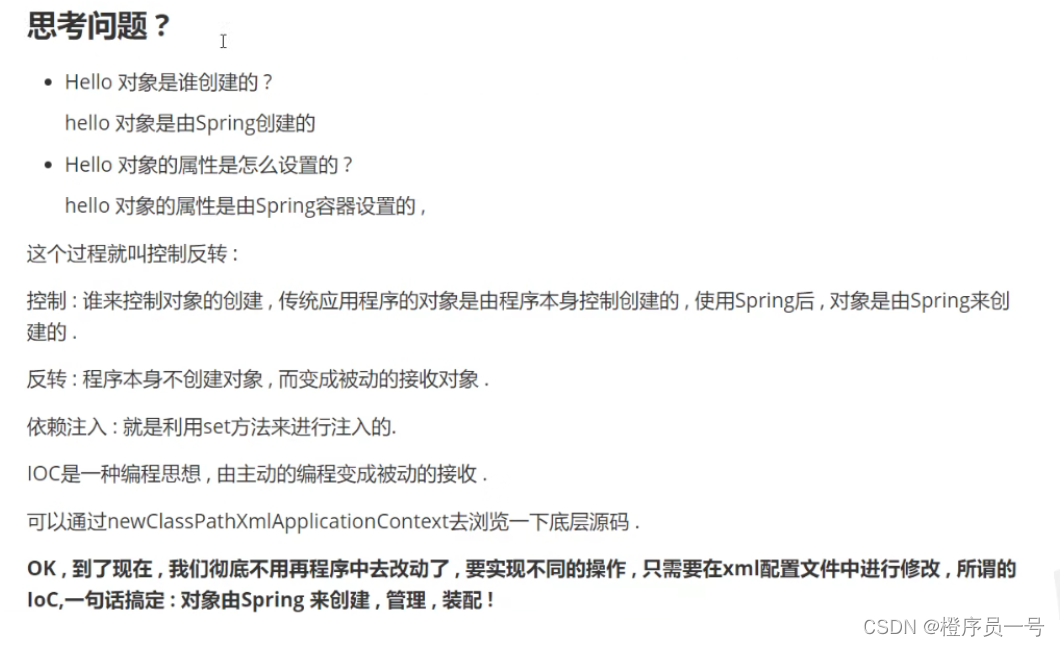
4.IOC创建对象的方式
-
使用无参构造创建对象,默认! 如果User类没有无参构造则报错
<bean id="user" class="com.kuang.pojo.User"><property name="name" value="秦江"/> </bean> -
假设我们要使用有参构造创建对象
-
下标赋值
<bean id="user" class="com.kuang.pojo.User"><constructor-arg index="0" value="狂神说java"/> </bean> -
通过类型创建,不建议使用,如果有两个同类型的参数,则会出错
<bean id="user" class="com.kuang.pojo.User"><constructor-arg type="java.lang.String" value="qingjanga"/> </bean> -
通过参数名来设置
<bean id="user" class="com.kuang.pojo.User"><constructor-arg name="name" value="sdfasdfasdf"/> </bean>
-
总结:在配置文件加载的时候,容器中管理的对象就已经初始化了
5、spring配置
5.1、别名
<alias name="user" alias-"userNew"/>
5.2、bean的配置
id:bean的唯一标识符
class bean对象所对应的全限定名
name:也是别名
<bean id="user" class="com.kuang.pojo.User" name="u1,u2,u3"><constructor-arg name="name" value="西部开源"/>
</bean>
5.3、import
一般用于团队开发使用,他可以将多个配置文件,导入合并为一个
假设,现在项目中有多个人开发,这三个人复制不同的类开发,不同的类需要注册在不同的bean中,我们可以利用import将所有的beans.xml合并为一个总的
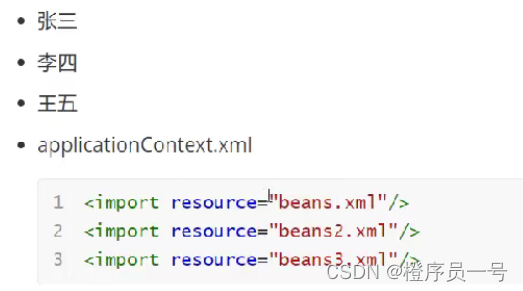
使用总配置即可
6、依赖注入
6.1构造器注入
前面已讲
6.2set方式注入 重点*
- 依赖注入:set注入
- 依赖:bean对象的创建依赖于容器
- 注入:bean对象中的所有属性,由容器来注入
【环境搭建】
-
复杂类型
public class Address {private String address;public Address() {}public String getAddress() {return address;}public void setAddress(String address) {this.address = address;}public Address(String address) {this.address = address;} } -
真实测试环境
public class Student {private String name;private Address address;private String[] books;private List<String> hobbys;private Map<String,String> card;private Set<String> games;private Properties info;private String wife; -
beans.xml
<?xml version="1.0" encoding="UTF-8"?> <beans xmlns="http://www.springframework.org/schema/beans"xmlns:xsi="http://www.w3.org/2001/XMLSchema-instance"xsi:schemaLocation="http://www.springframework.org/schema/beanshttps://www.springframework.org/schema/beans/spring-beans.xsd"><bean id="student" class="com.kuang.pojo.Student"><!--第一种方式:普通值注入--><property name="name" value="zzy"/></bean></beans> -
测试类
public class MyTest {public static void main(String[] args) {ApplicationContext context = new ClassPathXmlApplicationContext("beans.xml");Student student = (Student)context.getBean("student");System.out.println(student);
完善注入信息
<?xml version="1.0" encoding="UTF-8"?>
<beans xmlns="http://www.springframework.org/schema/beans"xmlns:xsi="http://www.w3.org/2001/XMLSchema-instance"xsi:schemaLocation="http://www.springframework.org/schema/beanshttps://www.springframework.org/schema/beans/spring-beans.xsd"><bean id="student" class="com.kuang.pojo.Student"><!--第一种方式:普通值注入--><property name="name" value="zzy"/><!--第二种,bean注入,ref--><property name="address" ref="address"/><!--数组注入,ref--><property name="books"><array><value>红楼梦</value><value>西游记</value><value>水浒传</value><value>三国演义</value></array></property><property name="hobbys"><list><value>听歌</value><value>敲代码</value><value>看电影</value></list></property><!--Map--><property name="card"><map><entry key="身份证" value="132115313212351513"/><entry key="银行卡" value="251616511515151"/></map></property><property name="games"><set><value>LOL</value><value>王者荣耀</value><value>反恐精英</value><value>炉石传说</value></set></property><!--null--><property name="wife"><null/></property><!--properties--><property name="info"><props><prop key="学号">2015014285</prop><prop key="姓名">小明</prop><prop key="性别">男</prop></props></property></bean><bean id="address" class="com.kuang.pojo.Address"><property name="address" value="浙江万里"/></bean>
</beans>
常用

6.3扩展方式注入
我们可以使用p命名空间和c命名空间进行注入
官方解释:(主要是带p和c那两行)
<?xml version="1.0" encoding="UTF-8"?>
<beans xmlns="http://www.springframework.org/schema/beans"xmlns:xsi="http://www.w3.org/2001/XMLSchema-instance"xmlns:p="http://www.springframework.org/schema/p"xmlns:c="http://www.springframework.org/schema/c"xsi:schemaLocation="http://www.springframework.org/schema/beanshttps://www.springframework.org/schema/beans/spring-beans.xsd">
使用!
<!--p命名空间注入,可以直接注入属性的值-->
<bean id="user" class="com.kuang.pojo.User" p:name="zzy" p:age="180"/>
<!--c命名空间注入,通过构造器注入:construct-args-->
<bean id="user2" class="com.kuang.pojo.User" c:age="18" c:name="zzy"/>
测试:
public static void main(String[] args) {ApplicationContext context = new ClassPathXmlApplicationContext("beans.xml");Student student = (Student)context.getBean("student");System.out.println(student);
/* com.kuang.pojo.Student{
name='zzy',
address=Address{address='浙江万里'},
books=[红楼梦, 西游记, 水浒传, 三国演义],
hobbys=[听歌, 敲代码, 看电影],
card={身份证=132115313212351513, 银行卡=251616511515151},
games=[LOL, 王者荣耀, 反恐精英, 炉石传说],
info={姓名=小明, 学号=2015014285, 性别=男},
wife='null'}*/}@Testpublic void Test1(){ApplicationContext context = new ClassPathXmlApplicationContext("userbeans.xml");User user = (User)context.getBean("user2");System.out.println(user);}
注意点:p命名空间和c命名空间不能直接使用,需要导入xml约束
xmlns:p="http://www.springframework.org/schema/p"xmlns:c="http://www.springframework.org/schema/c"
6.4bean的作用域
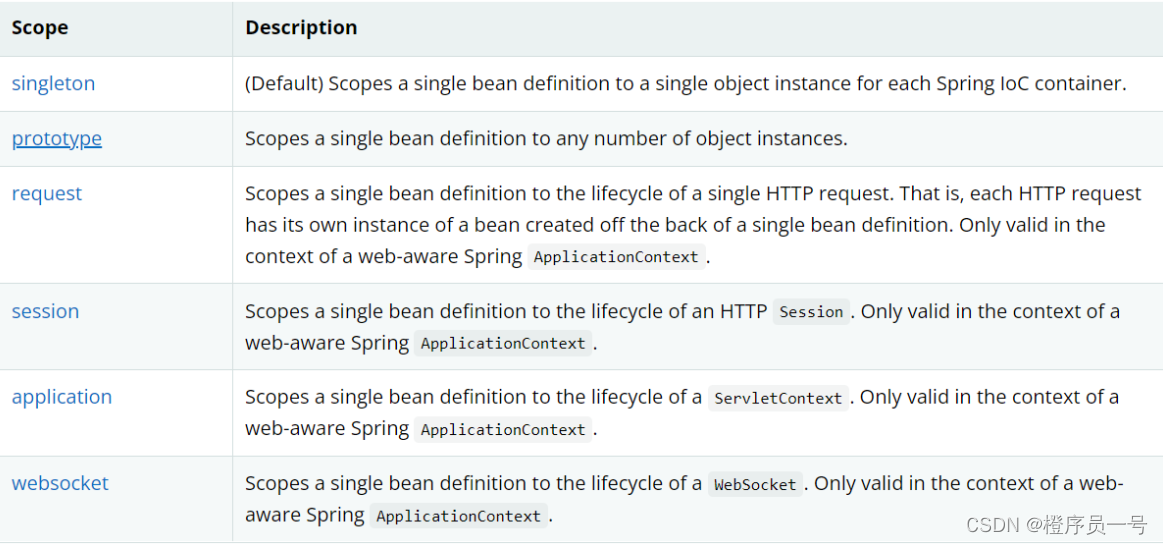
- 代理模式(Spring默认机制)、

<!--c命名空间注入,通过构造器注入:construct-args-->
<bean id="user2" class="com.kuang.pojo.User" c:age="18" c:name="zzy" scope="singleton"/>
-
原型模式 :每次从容器中get的时候,都会产生一个新对象!
<!--c命名空间注入,通过构造器注入:construct-args--> <bean id="user2" class="com.kuang.pojo.User" c:age="18" c:name="zzy" scope="prototype"/> -
其余的request、session、application这些只能在web开发中使用到
7.bean的自动装配
- 自动装配是spring满足bean依赖的一种方式!
- spring会在上下文自动寻找,并自动给bean装配属性!
在spring中有三种装配的方式
- 在xml中显示的配置
- 在java中显示配置
- 隐式的自动装配bean 【重要】
7.1 测试
环境搭建,一个人有两个宠物
<bean id="cat" class="com.kuang.pojo.Cat"/>
<bean id="dog" class="com.kuang.pojo.Dog"/>
<bean id="people" class="com.kuang.pojo.People"><property name="name" value="常雾岩"/><property name="dog" ref="dog"/><property name="cat" ref="cat"/>
</bean>
7.2、ByName自动装配
byname会自动在容器上下文中查找,和自己对象set方法后面的值对应的beanid!
<bean id="cat" class="com.kuang.pojo.Cat"/>
<bean id="dog" class="com.kuang.pojo.Dog"/>
<bean id="people" class="com.kuang.pojo.People" autowire="byName"><property name="name" value="常雾岩"/>
</bean>
7.3 ByType自动装配
类型必须全局唯一
<bean id="cat11" class="com.kuang.pojo.Cat"/>
<bean id="dog22" class="com.kuang.pojo.Dog"/>
<bean id="people" class="com.kuang.pojo.People" autowire="byType"><property name="name" value="常雾岩"/>
</bean>
小结:
- byname的时候,需要保证所有bean的id唯一,并且这个bean需要和自动注入的属性的set方法的值一致
- bytype的时候,需要保证所有bean的class唯一,并且这个bean需要和自动注入的属性类型一致
7.4、使用注解实现自动装配
jdk1.5支持的注解,spring2.5就支持注解了
需使用注解须知:
- 导入约束:context约束
- 配置注解的支持:context:annotation-config/
`<?xml version="1.0" encoding="UTF-8"?>
<beans xmlns="http://www.springframework.org/schema/beans"xmlns:xsi="http://www.w3.org/2001/XMLSchema-instance"xmlns:context="http://www.springframework.org/schema/context"xsi:schemaLocation="http://www.springframework.org/schema/beanshttps://www.springframework.org/schema/beans/spring-beans.xsdhttp://www.springframework.org/schema/contexthttps://www.springframework.org/schema/context/spring-context.xsd"><context:annotation-config/></beans>
@Autowired
直接在属性上使用即可!也可以在set方式上使用!
使用autowired我们可以不用编写set方法了,前提是你这个自动装配的属性在IOC(spring)容器中存在,且符合名字byname!
科普:
@Nullable 字段标记了这个注解,说明这个字段可以为null;
public @interface Autowired {boolean required() default true;
}
@Autowired(required=false)
如果显示定义了Autowired的required属性为false,说明这个对象可以为null,否则不允许为空
如果@Autowired自动装配的环境比较复杂,自动装配无法通过一个注解@Autowired完成的时候,我们可以使用@Qualifier(value=“xxx”)去配置@Autowired使用(这里的xxx是bean里面的id),指定一个唯一的bean对象注入
public class People {@Autowired@Qualifier(value = "cat333")private Cat cat;@Autowired@Qualifier(value = "dog222")private Dog dog;private String name;
还有@Resource注解,也可以完成上述的@Autowired,最常用的是@Autowired
@Resource注解
public class People{@Resource(name="cat2")private Cat cat;@Resourceprivate Dog dog;
}
小结
@Resource和@Autowired的区别:
- 都是用来自动装配的,都可以放在属性字段上
- @Autowired通过byname的方式实现,而且必须要求这个对象存在
- @Resource默认通过byname方式实现,如果找不到名字,则通过bytype实现,如果两个都找不到的情况下,就报错
- 执行顺序不同:@Autowired 通过byType的方式实现
8、使用注解开发
在spring4之后,要使用注解开发,必须导入aop包
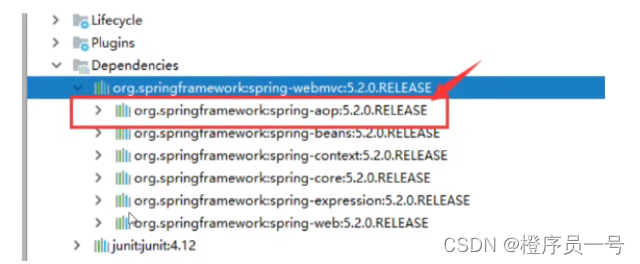
使用注解需要入context约束,增加注解的支持!
-
bean
<?xml version="1.0" encoding="UTF-8"?> <beans xmlns="http://www.springframework.org/schema/beans"xmlns:xsi="http://www.w3.org/2001/XMLSchema-instance"xmlns:context="http://www.springframework.org/schema/context"xsi:schemaLocation="http://www.springframework.org/schema/beanshttps://www.springframework.org/schema/beans/spring-beans.xsdhttp://www.springframework.org/schema/contexthttps://www.springframework.org/schema/context/spring-context.xsdhttp://www.springframework.org/schema/aophttps://www.springframework.org/schema/aop/spring-aop.xsd"><!--开启注解的支持--><context:annotation-config/></beans> -
属性如何注入
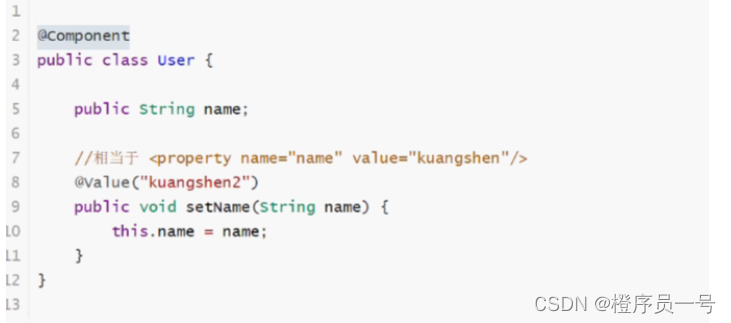
-
衍生的注解
@Component有几个衍生注解,我们在web开发中,会按照mvc三层架构分层
-
dao 【@Repository】
-
service 【@Service】
-
controller 【@Controller】
这四个注解的功能都是一样的,都是代表将某个类注册到spring容器中,装配bean
-
-
自动装配

-
作用域
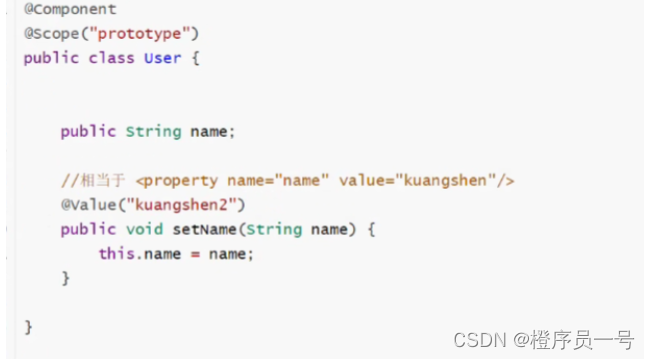
-
小结
xml与注解:
- xml更加万能,适用于任何场合!维护简单方便
- 注解不是自己类使用不了,维护相对复杂!
xml与注解最佳实践
- xml用来管理bean
- 注解只负责完成属性的注入
- 我们在使用的过程中,只需要注意一个问题:必须让注解生效,就需要开启注解的支持
<!--开启注解的支持-->
<context:annotation-config/>
<!--指定要扫描的包,这个包下的注解就会生效-->
<context:component-scan base-package="com.kuang"/>
@Component:组件,放在类上,说明这个类被spring管理了,就是bean!
@Value:放在变量上,给变量赋值。当属性较少并且复杂度低时使用,属性很复杂建议直接使用配置文件
9.使用java的方式配置spring
我们现在要完全不适用spring的xml配置了,全权交给java来做!
javaConfig是spring的一个子项目
实体类
package com.kuang.pojo;import org.springframework.beans.factory.annotation.Value;
import org.springframework.stereotype.Component;
//这里的注解意思是:这个类被spring接管了,注册到了容器中
@Component
public class User {@Value("楚云升")private String name;@Overridepublic String toString() {return "User{" +"name='" + name + '\'' +'}';}public String getName() {return name;}public void setName(String name) {this.name = name;}
}
配置文件
package com.kuang.config;import com.kuang.pojo.User;
import org.springframework.context.annotation.Bean;
import org.springframework.context.annotation.ComponentScan;
import org.springframework.context.annotation.Configuration;
import org.springframework.context.annotation.Import;
//这个也会被spring容器托管,注册到容器中,因为它本来就是一个@Component @Configuration代表这是一个配置类
//就和我们之前看的beans.xml@Configuration
@ComponentScan("com.kuang.pojo")
@Import(KuangConfig2.class)
public class KuangConfig {//注册一个bean,就相当于我们之前写的一个bean标签//这个方法的名字,就相当于bean标签中的id属性//这个方法的返回值,就相当于bean标签中的class属性@Beanpublic User getUser(){return new User();}
}
测试类!
public class MyTest {public static void main(String[] args) {//如果完全使用了配置类的方式去做,我们就只能通过AnnotationConfig上下文来获取容器,通过配置类的class对象加载ApplicationContext context = new AnnotationConfigApplicationContext(KuangConfig.class);User user = (User)context.getBean("getUser");System.out.println(user);}
}
这种纯java的配置文件,在springboot中随处可见!
以上的纯java配置文件,可以与xml配置文件相对于的看,相对于两种方法
10、代理模式
为什么要学习代理模式?因为这就是springAOP的底层!!! 【SpringAOP和SpringMVC,面试必问】
代理模式的分类
- 静态代理
- 动态代理
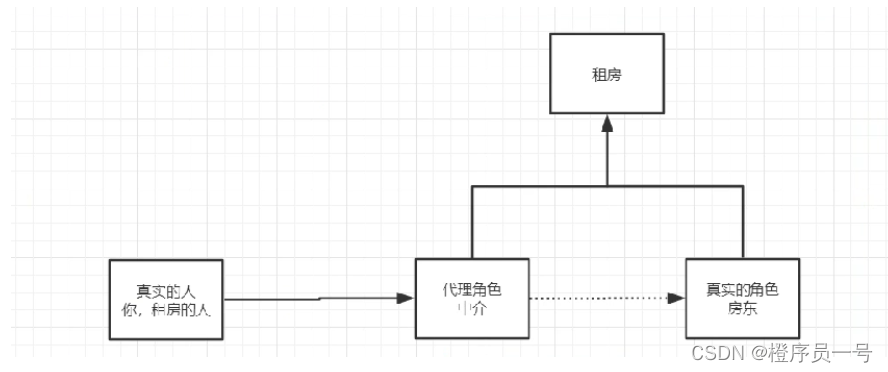
10.1 静态代理
角色分析:
- 抽象角色:一般会使用接口或抽象类来解决
- 真实角色:被代理的角色
- 代理角色:代理真实角色,代理真实角色后,我们一般会做些附属操作
- 客户:访问代理对象的人
代码步骤:
-
接口
//租房 public interface Rent {public void rent(); } -
真实角色
public class Host implements Rent{public void rent() {System.out.println("房东要出租房子!");} } -
代理角色
package com.kuang.demo01;public class Proxy implements Rent{private Host host;public Proxy(Host host) {this.host = host;}public Proxy() {}public void rent() {host.rent();seeHouse();heTong();fare();}//看房public void seeHouse(){System.out.println("中介带你看房!");}//收中介费public void fare(){System.out.println("收取中介费!!");}//看房public void heTong(){System.out.println("签租赁合同! ");} } -
客户端访问代理角色
public class Client {public static void main(String[] args) {Host host = new Host();Proxy proxy = new Proxy(host);proxy.rent();} }
代理模式的好处!
- 可以使真实角色的操作更加纯粹!不用去关注一些公共的业务
- 公共也就交给代理角色,实现了业务的分工
- 公共业务发生扩展的时候,方便集中管理!
缺点:
- 一个真实角色就会产生一个代理角色:代码量会翻倍开发效率会变低
10.2 加深理解
代理,减少对原代码的修改,通过代理的方式,给原程序增加功能,并不做修改
AOP聊聊
代码:对应08-demo02
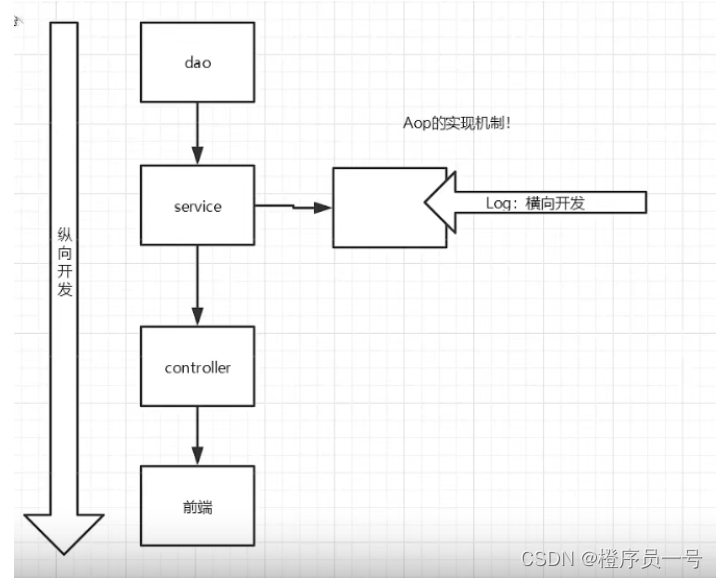
10.3 动态代理
- 动态代理和静态代理角色一样
- 动态代理的代理类是动态生成的,不是我们直接写好的
- 动态代理分为两大类:基于接口的动态代理,基于类的动态代理
- 基于接口–JDK动态代理【我们在这里使用】
- 基于类:cglib
- java字节码实现:javasist
需要了解两个类:Proxy(代理),InvocationHandler:调用处理程序
动态代理的好处:
- 可以使真实角色的操作更加纯粹!不用去关注一些公共的业务
- 公共也就交给代理角色,实现了业务的分工
- 公共业务发生扩展的时候,方便集中管理!
- 一个动态代理类代理的是一个接口,一般就是对应的一类业务
- 一个动态代理类可以可以代理多个类,只要是实现了同一个接口即可
11、AOP
11.1、什么是AOP

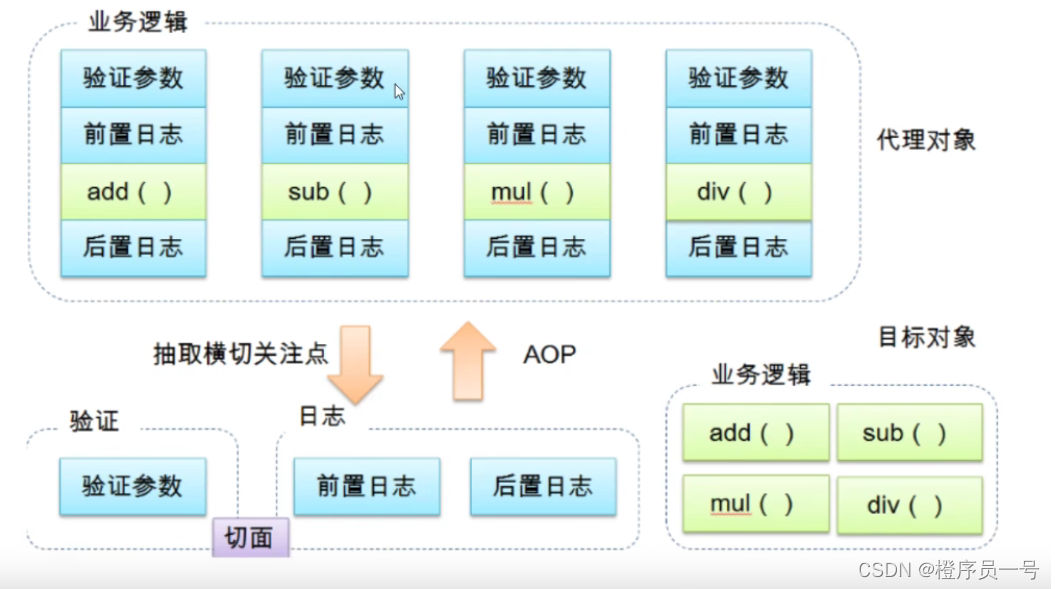
11.2 AOP在Spring中的作用
提供声明式事务:允许用户自定义切面

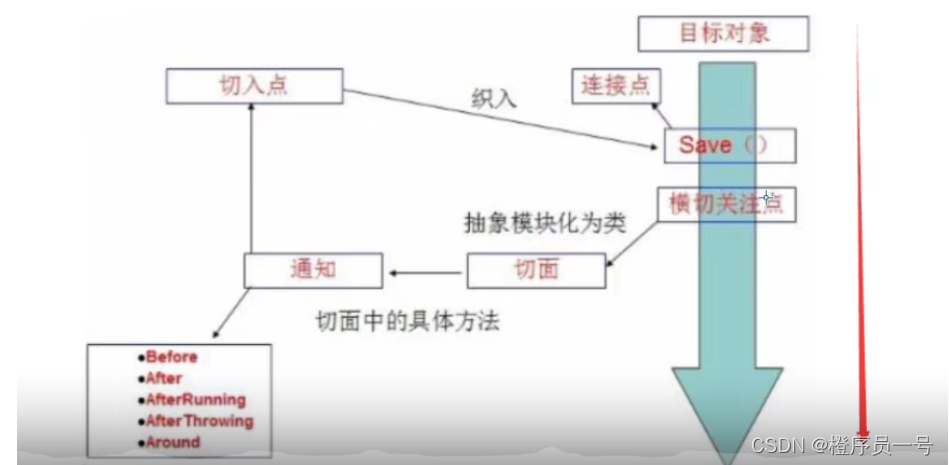
11.3 使用spring实现AOP
使用AOP,需要导入一个依赖包
<dependency><groupId>org.aspectj</groupId><artifactId>aspectjweaver</artifactId><version>1.9.6</version></dependency>
方式一:使用spring的API接口 【主要springAPI接口实现】
方式二:自定义实现AOP 【主要是切面定义】 建议第二种
方式三:使用注解实现!
12、整合MyBatis
步骤
- 导入相关jar包
- junit
- mybatis
- mysql数据库
- spring相关的
- aop植入
- mybatis-spring 【new】
- 编写配置文件
- 测试
12.1 回忆mybatis
-
编写实体类
-
编写核心配置文件
-
编写接口
-
编写数据源配置
-
SqlSessionFactory
-
SqlSessionTemplate
-
需要给接口加实现类
-
将自己写的实现类,注入到spring中
-
测试使用即可
13、声明式事务
1、回顾事务
- 把一组事务当成一个业务来做,要么都成功,要么都失败
- 事务在项目开发中,十分重要,涉及到数据一致性问题,不能马虎!
- 确保完整性和一致性
事务的ACID原则:
- 原子性 atomicity
- 一致性 consistency
- 持久性 isolation
- 事务一旦提交,无论系统发生什么问题,结果都不会再被影响,被持久化写到储存器里
- 隔离性 durability
- 多个业务可能操作同一个资源,防止数据破坏
2、spring中的事务管理
- 声明式事务:AOP (交由容器管理事务)
- 编程式事务管理:需要再代码中,进行事务的管理
为什么需要事务?
- 如果不配置事务,可能存在数据提交不一致的情况;
- 如果我们不做spring中配置声明式事务,我们就需要在代码中手动配置事务
- 事务在项目的开发中十分重要,设计到数据的一致性和完整性,不容马虎!





